The Effects of Climatic and Cultural Changes on Grain Agriculture in Northwest Washington
Abstract
1. Introduction
Today, people often ask me if it is possible to grow wheat and oats on the San Juan Islands, in Skagit Valley, or basically in any place out of place. The farm memory is gone. It has vanished along with the infrastructure that once supported it … Little remains to remind us that thousands of communities once had vibrant local grain systems in place for food, feed, and malt.
2. Materials and Methods
2.1. Study Area
2.2. Historical Agricultural Census Records
2.3. Climate Data
2.4. Land Zoning and Soil Data
2.5. Interviews
3. Results
3.1. Declining Cereal Grain Farms and Acreage
3.2. Changes in Cereal Grain Output
3.3. Historical Shifts in Temperature Suitability for Wheat
3.4. Future Temperature Suitability for Wheat
3.5. Available Areas to Grow Wheat
3.6. Interview Results
Baker 4: There’s a lot of good people here … that’s what kept me here. And the reason I wanted to set up shop here beyond that was just to build our community more.
Farmer and Baker 2: Two drivers making these decisions in terms of the ingredients we use in the bakery and how we use them. One, human health in our community, people eating in our bread, and two, landscape health both in the community and further field as we source our ingredients further away.
Farmer 1: This area’s one of the most sustainable because of the rains we get, the type of soil we have, the proximity to markets … we feel like we’re part of a real, sustainable food system.
Farmer and Baker 2: The concept of growing grain at a small scale seems more available to farmers now than it did when we first moved here.
Baker 3: It seems like it’s only expanding, and people are embracing locally grown grain.
Miller 1: The biggest challenge now is cost increases—fuel, freight, land rent.
Farmer 3: If I was really getting serious about grain … the equipment alone, like a good combine, you can drop fifty grand, a hundred grand, depending on what scale you want.
Baker 1: I think that … through places like Cairnspring [Mill] or maybe wanting to do another mill, we could see more grain being grown here.
Baker 4: The state of our climate is obviously a huge factor. It’s going to be really rough for all of us. So, [we should] just have hope but also caution and action.
Baker 1: I do worry that just in general, the research being done for climate change is not [going to] happen fast enough for what we’re going through.
Miller 1: Wheat is one of the most adaptable crops … that we can cultivate to be viable as we see the impacts of climate change. We’re seeing a tremendous amount of market demand for regeneratively grown grains.
Farmer 3: When you look at climate change and other things that affect food production, places like this are more and more being recognized as being of extreme value.
Farmer 1: I think [grain] is just going to get more varieties, more diverse, better for the consumer.
4. Discussion
4.1. Census Records
4.2. Changing Temperature
4.3. Farmer and Baker Decision-Making
5. Conclusions
Author Contributions
Funding
Institutional Review Board Statement
Informed Consent Statement
Data Availability Statement
Acknowledgments
Conflicts of Interest
Appendix A. Interview Search Terms
Appendix B. Interview Questions
References
- Béné, C.; Oosterveer, P.; Lamotte, L.; Brouwer, I.D.; de Haan, S.; Prager, S.D.; Talsma, E.F.; Khoury, C.K. When food systems meet sustainability–Current narratives and implications for actions. World Dev. 2019, 113, 116–130. [Google Scholar] [CrossRef]
- Brinkley, C. Visualizing the social and geographical embeddedness of local food systems. J. Rural Stud. 2017, 54, 314–325. [Google Scholar] [CrossRef]
- Simons, K. Northeastern bakers’ views on organic and regeneratively certified flours. J. Agric. Food Syst. Community Dev. 2023, 13, 267–279. [Google Scholar] [CrossRef]
- Hoogenboom, A.; Sloane, E.; Canty, D. Planting the Seeds: Moving to More Local Food in Western Washington. Available online: https://farmlandinfo.org/wp-content/uploads/sites/2/2019/09/AFTPlantingTheSeedsF.pdf (accessed on 14 January 2025).
- Hills, K.M.; Goldberger, J.R.; Jones, S.S. Commercial bakers’ view on the meaning of” local” wheat and flour in western Washington State. J. Agric. Food Syst. 2013, 3, 13–32. [Google Scholar] [CrossRef]
- Enthoven, L.; Van den Broeck, G. Local food systems: Reviewing two decades of research. Agric. Syst. 2021, 193, 103226. [Google Scholar] [CrossRef]
- USDA National Agricultural Statistics Service. Market Value of Agricultural Products Sold Including Food Marketing Practices and Value-Added Products. 2022. Available online: https://www.nass.usda.gov/Publications/AgCensus/2022/Full_Report/Volume_1,_Chapter_2_County_Level/Washington/st53_2_002_002.pdf (accessed on 14 January 2025).
- Brouwer, B.O.; Murphy, K.M.; Jones, S.S. Plant breeding for local food systems: A contextual review of end-use selection for small grains and dry beans in Western Washington. Renew. Agric. Food Syst. 2016, 31, 172–184. [Google Scholar] [CrossRef]
- Kershner, J. Wheat Farming in Washington. Available online: https://historylink.org/File/20504?_gl=1*1m2oiwc*_ga*MTkwNTk0NDE1NS4xNzMyODM4MjM2*_ga_3W5XJDRM1X*MTczMjgzODIzNS4xLjEuMTczMjgzODI0OS40Ni4wLjA (accessed on 14 February 2025).
- Jones, S. Kicking the commodity habit: On being grown out of place. Gastronomica 2012, 12, 74–77. [Google Scholar] [CrossRef]
- Dimitri, C.; Effland, A.; Conklin, N.C. The 20th Century Transformation of US Agriculture and Farm Policy. Available online: https://ageconsearch.umn.edu/record/59390// (accessed on 14 January 2025).
- Hendrickson, M.; James, H.S. The Ethics of Constrained Choice: How the Industrialization of Agriculture Impacts Farming and Farmer Behavior. J. Agric. Environ. Ethics 2005, 18, 269–291. [Google Scholar] [CrossRef]
- Schapsmeier, E.; Schapsmeier, F. Eisenhower and Ezra Taft Benson: Farm Policy in the 1950s. Agric. Hist. 1970, 44, 369–378. [Google Scholar]
- Washington Grain Commission. Wheat. Available online: https://wagrains.org/wheat/#:~:text=The%20vast%20majority%20of%20wheat,between%20crops%20to%20accumulate%20moisture (accessed on 14 January 2025).
- Winkler, L.R.; Murphy, K.M.; Jones, S.S. The history of oats in western Washington and the evolution of regionality in agriculture. J. Rural. Stud. 2016, 47, 231–241. [Google Scholar] [CrossRef]
- Cairnspring Mills. Local Milling Is Back. Available online: https://cairnspring.com/pages/our-story (accessed on 14 January 2025).
- WSU Bread Lab. About Us. Available online: https://breadlab.wsu.edu/about-us/ (accessed on 14 January 2025).
- Jones, S.; Econopouly, B. Breeding away from all purpose. Agroecol. Sustain. Food Syst. 2018, 42, 712–721. [Google Scholar] [CrossRef]
- Rempelos, L.; Wang, J.; Sufar, E.K.; Almuayrifi, M.S.B.; Knutt, D.; Leifert, H.; Leifert, A.; Wilkinson, A.; Shotton, P.; Hasanaliyeva, G.; et al. Breeding Bread-Making Wheat Varieties for Organic Farming Systems: The Need to Target Productivity, Robustness, Resource Use Efficiency and Grain Quality Traits. Foods 2023, 12, 1209. [Google Scholar] [CrossRef] [PubMed]
- Murphy, K.; Carter, A.; Jones, S. Evolutionary breeding and climate change. In Genomics and Breeding for Climate-Resilient Crops: Vol. 1 Concepts and Strategies, 1st ed.; Kole, C., Ed.; Springer: Berlin/Heidelberg, Germany, 2013; pp. 377–389. ISBN 978-3-642-37044-1. [Google Scholar]
- Chen, D.; Chen, H.W. Using the Köppen classification to quantify climate variation and change: An example for 1901–2010. Environ. Dev. 2013, 6, 69–79. [Google Scholar] [CrossRef]
- Peel, M.C.; Finlayson, B.L.; McMahon, T.A. Updated world map of the Köppen-Geiger climate classification. Hydrol. Earth Syst. Sci. 2007, 11, 1633–1644. [Google Scholar] [CrossRef]
- Western Regional Climate Center. Climate of Washington. Available online: https://wrcc.dri.edu/Climate/narrative_wa.php (accessed on 14 January 2025).
- PRISM Climate Group. 30-Year Normals Data [Dataset]; PRISM Climate Data: Corvallis, OR, USA, 2022; Available online: https://prism.oregonstate.edu (accessed on 14 January 2025).
- Wang, T.; Hamann, A.; Spittlehouse, D.; Carroll, C. Locally Downscaled and Spatially Customizable Climate Data for Historical and Future Periods for North America [Dataset]; Historical and Projected Climate Data for North America (ClimateNA): Alberta, CA, USA, 2016. [Google Scholar] [CrossRef]
- United States Census Bureau. Agriculture—Cereal Production in 1889: Illinois, Indiana, Oregon, Washington (No. 181). Available online: https://www2.census.gov/library/publications/decennial/1890/bulletins/agriculture/181-agriculture-cereal-production-in-1889-il-in-or-wa.pdf (accessed on 14 January 2025).
- United States Census Bureau. Acreage and Production of Barley, Buckwheat, Corn, Oats, Rye, and Wheat in 1899, by Counties. Available online: https://www2.census.gov/library/publications/decennial/1900/volume-6/volume-6-p3.pdf (accessed on 14 January 2025).
- United States Census Bureau. Agriculture—Washington. Available online: https://www2.census.gov/library/publications/decennial/1910/volume-7/volume-7-p8.pdf (accessed on 14 January 2025).
- United States Census Bureau. Bulletin—Agriculture: Washington, Statistics for the State and Its Counties. Available online: https://www2.census.gov/library/publications/decennial/1920/bulletins/agriculture/agriculture-wa.pdf (accessed on 14 January 2025).
- USDA National Agricultural Statistics Service. Value of Crops and Acreage and Production of Principal Crops. Available online: https://agcensus.library.cornell.edu/wp-content/uploads/1925-Washington-County_Tables-Table-04.pdf (accessed on 14 January 2025).
- USDA National Agricultural Statistics Service. Acreage and Quantity of Small Grains, Hay Crops, Sorghums, Corn, and Other Principal Field Crops, Harvested in 1934 and 1929. Available online: https://agcensus.library.cornell.edu/wp-content/uploads/1935-Washington-COUNTY_TABLES-1514-Table-03.pdf (accessed on 14 January 2025).
- USDA National Agricultural Statistics Service. Specified Crops Harvested: Censuses of 1945. Available online: https://agcensus.library.cornell.edu/wp-content/uploads/1945-Washington-COUNTY_TABLES-1171-Table-02.pdf (accessed on 14 January 2025).
- USDA National Agricultural Statistics Service. Specified Crops Harvested: Censuses of 1954. Available online: https://agcensus.library.cornell.edu/wp-content/uploads/1954-Washington-CHAPTER_B_-_STATISTICS_FOR_COUNTIES-1165-Table-09.pdf (accessed on 14 January 2025).
- USDA National Agricultural Statistics Service. Acreage, Quantity, and Sales of Crops Harvested: 1964. Available online: https://agcensus.library.cornell.edu/wp-content/uploads/1964-Washington-COUNTY_TABLES-809-Table-13.pdf (accessed on 14 January 2025).
- USDA National Agricultural Statistics Service. Corn, Sorghums, Wheat. Available online: https://agcensus.library.cornell.edu/wp-content/uploads/1969-Washington-Chapter_2._County_Summary_Data_For_Selected_Items_1969-483-Table-12.pdf (accessed on 14 January 2025).
- USDA National Agricultural Statistics Service. Grains—Corn, Sorghum, Wheat, and Other Small Grains: 1982. Available online: https://agcensus.library.cornell.edu/wp-content/uploads/1982-Washington-CHAPTER_2_County_Data-122-Table-24.pdf (accessed on 14 January 2025).
- USDA National Agricultural Statistics Service. Grains—Corn, Sorghum, Wheat, and Other Small Grains: 1992. Available online: https://agcensus.library.cornell.edu/wp-content/uploads/1992-Washington-CHAPTER_2_County_Data-1570-Table-26.pdf (accessed on 14 January 2025).
- USDA National Agricultural Statistics Service. Field Crops: Grains—Corn, Sorghum, Wheat, and Other Field Crops: 2002. Available online: https://agcensus.library.cornell.edu/wp-content/uploads/2002-Washington-CountyData-Table-24.pdf (accessed on 14 January 2025).
- USDA National Agricultural Statistics Service. Field Crops: 2012. Available online: https://agcensus.library.cornell.edu/wp-content/uploads/2012-Washington-st53_2_025_025.pdf (accessed on 14 January 2025).
- USDA National Agricultural Statistics Service. Field Crops: 2022. Available online: https://www.nass.usda.gov/Publications/AgCensus/2022/Full_Report/Volume_1,_Chapter_2_County_Level/Washington/st53_2_025_025.pdf (accessed on 14 January 2025).
- Kott, P. SAMPLING ERRORS—NECESSARY BUT CONTROLLABLE. Available online: https://www.nass.usda.gov/Education_and_Outreach/Understanding_Statistics/Statistical_Aspects_of_Surveys/sampling_errors.pdf (accessed on 14 January 2025).
- U.S. Geological Survey. USGS 1/3 Arc Second n49w121 (20220919) [Dataset]. 3D Elevation Program, VA, USA, 2022. Available online: https://www.sciencebase.gov/catalog/item/632a9a8ed34e71c6d67b9598 (accessed on 14 January 2025).
- U.S. Geological Survey. USGS 1/3 Arc Second n49w122 (20220919) [Dataset]. 3D Elevation Program, VA, USA, 2022. Available online: https://www.sciencebase.gov/catalog/item/640824fcd34e76f5f75e4051 (accessed on 14 January 2025).
- U.S. Geological Survey. USGS 1/3 arc-second n49w123 (1 x 1 degree) [Dataset]. 3D Elevation Program, VA, USA, 2022. Available online: https://www.sciencebase.gov/catalog/item/5f7784c682ce1d74e7d6ca60 (accessed on 14 January 2025).
- U.S. Geological Survey. USGS 1/3 arc-second n49w124 (1 x 1 degree) [Dataset]. 3D Elevation Program, VA, USA, 2022. Available online: https://www.sciencebase.gov/catalog/item/5f7783c282ce1d74e7d6c19a (accessed on 14 January 2025).
- Griffee, P. Triticum aestivum L. Available online: http://ecoport.org/perl/ecoport15.pl?searchType=entityDisplay&entityId=2114 (accessed on 14 January 2025).
- Porter, J.R.; Gawith, M. Temperatures and the growth and development of wheat: A review. Eur. J. Agron. 1999, 10, 23–36. [Google Scholar] [CrossRef]
- Sys, C.; Van Ranst, E.; Debaveye, J.; Beernaert, F. Land Evaluation Part III: Crop Requirements; Agricultural Publications n° 7, GADC: Brussels, BE, USA, 1993. [Google Scholar]
- USDA National Agricultural Statistics Service. Field Corn for Grain, Sorghums for Grain, Wheat for Grain. Available online: https://agcensus.library.cornell.edu/wp-content/uploads/1974-Washington-CHAPTER_2._County_Summary_Data-306-Table-18.pdf (accessed on 14 January 2025).
- Zabel, F.; Putzenlechner, B.; Mauser, W. Global Agricultural Land Resources–A High Resolution Suitability Evaluation and Its Perspectives until 2100 under Climate Change Conditions. PLoS ONE 2014, 9, e114980. [Google Scholar] [CrossRef]
- Flower, A. Salish Sea Bioregion Agricultural Areas Data [Dataset]; Salish Sea Atlas: Bellingham, WA, USA; Available online: https://wp.wwu.edu/salishseaatlas/data/ (accessed on 14 February 2025).
- Natural Resources Conservation Service Staff. Web Soil Survey [Database]; SSURGO: Washington, DC, USA, 2022. Available online: https://websoilsurvey.sc.egov.usda.gov/App/WebSoilSurvey.aspx (accessed on 25 November 2024).
- Havilah, E.J. Forages and pastures| Annual forage and pasture crops–establishment and management. In Encyclopedia of Dairy Sciences; Academic Press: Cambridge, MA, USA, 2011; pp. 563–575. [Google Scholar] [CrossRef]
- Lemus, R. Small Grain Cereals for Forage Production. Available online: https://extension.msstate.edu/sites/default/files/newsletter/forage-news/2017/2017_September.pdf (accessed on 14 January 2025).
- Parker, C.; Scott, S.; Geddes, A. Snowball Sampling; SAGE Publications Ltd.: London, UK, 2019. [Google Scholar] [CrossRef]
- Couzy, C.; Dockes, A.C. Are farmers businesspeople? Highlighting transformations in the profession of farmers in France. Int. J. Entrep. Small Bus. 2008, 6, 407–420. [Google Scholar] [CrossRef]
- Horseman, S.V.; Roe, E.J.; Huxley, J.N.; Bell, N.J.; Mason, C.S.; Whay, H.R. The use of in-depth interviews to understand the process of treating lame dairy cows from the farmers’ perspective. Anim. Welf. 2014, 23, 157–165. [Google Scholar] [CrossRef]
- Rev. About Rev. Available online: https://www.rev.com/about-rev?&gclid=Cj0KCQiAhbi8BhDIARIsAJLOludfJMWQmusvlCOqU8abrbwFcm5M3ozomI5BpLZ5ggNNNuHu04A-DWYaAnhCEALw_wcB&utm_source=google&utm_medium=cpc&utm_campaign=22017110835&utm_adgroup=&utm_term=&utm_content=&gad_source=1 (accessed on 14 January 2025).
- Basurto, X.; Speer, J. Structuring the calibration of qualitative data as sets for qualitative comparative analysis (QCA). Field Methods 2012, 24, 155–174. [Google Scholar] [CrossRef]
- Morse, W.C.; Lowery, D.R.; Steury, T. Exploring saturation of themes and spatial locations in qualitative public participation geographic information systems research. Soc. Nat. Resour. 2014, 27, 557–571. [Google Scholar] [CrossRef]
- Ranney, M.L.; Meisel, Z.F.; Choo, E.K.; Garro, A.C.; Sasson, C.; Morrow Guthrie, K. Interview-based qualitative research in emergency care part II: Data collection, analysis and results reporting. Acad. Emerg. Med. 2015, 22, 1103–1112. [Google Scholar] [CrossRef] [PubMed]


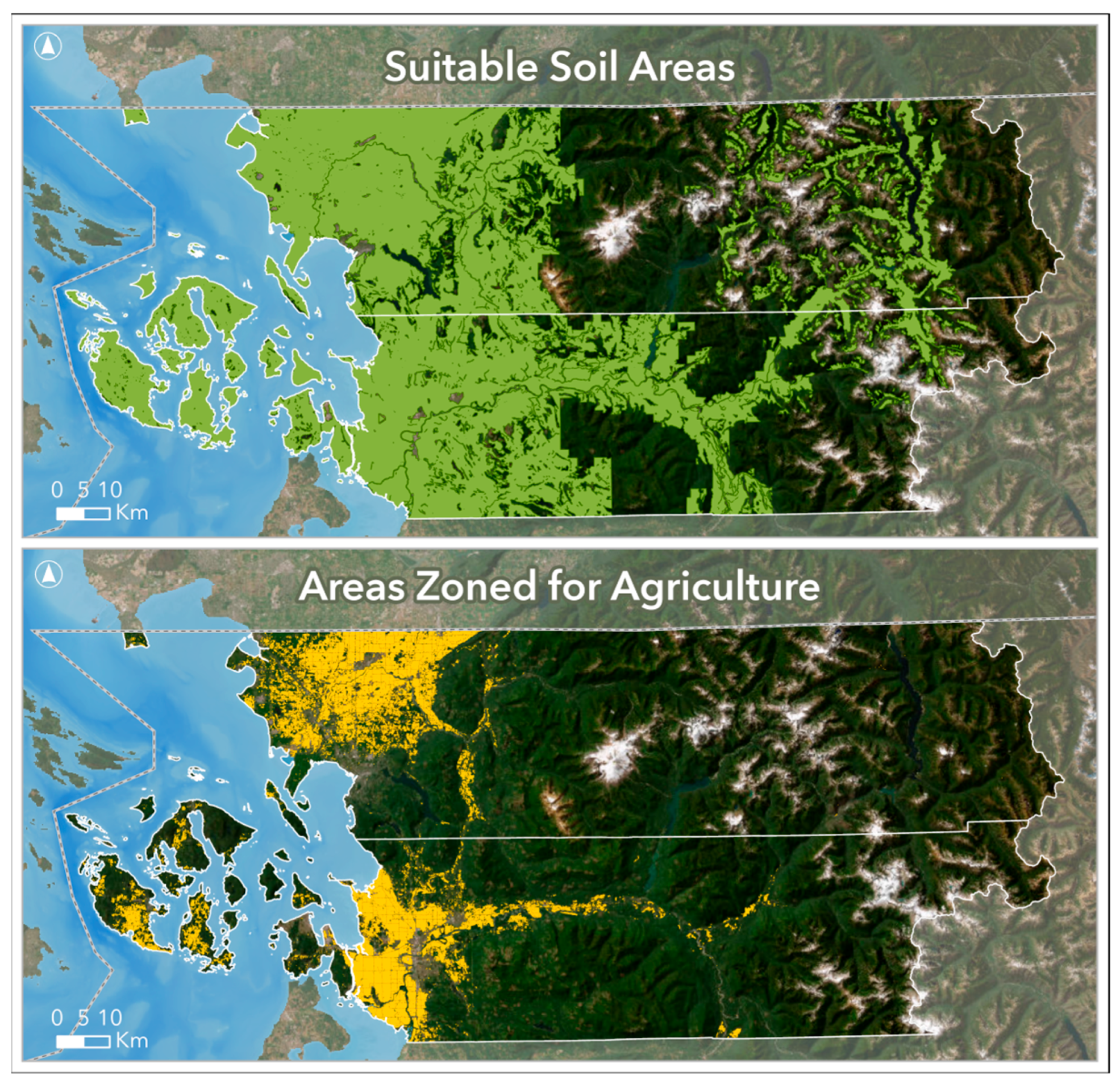



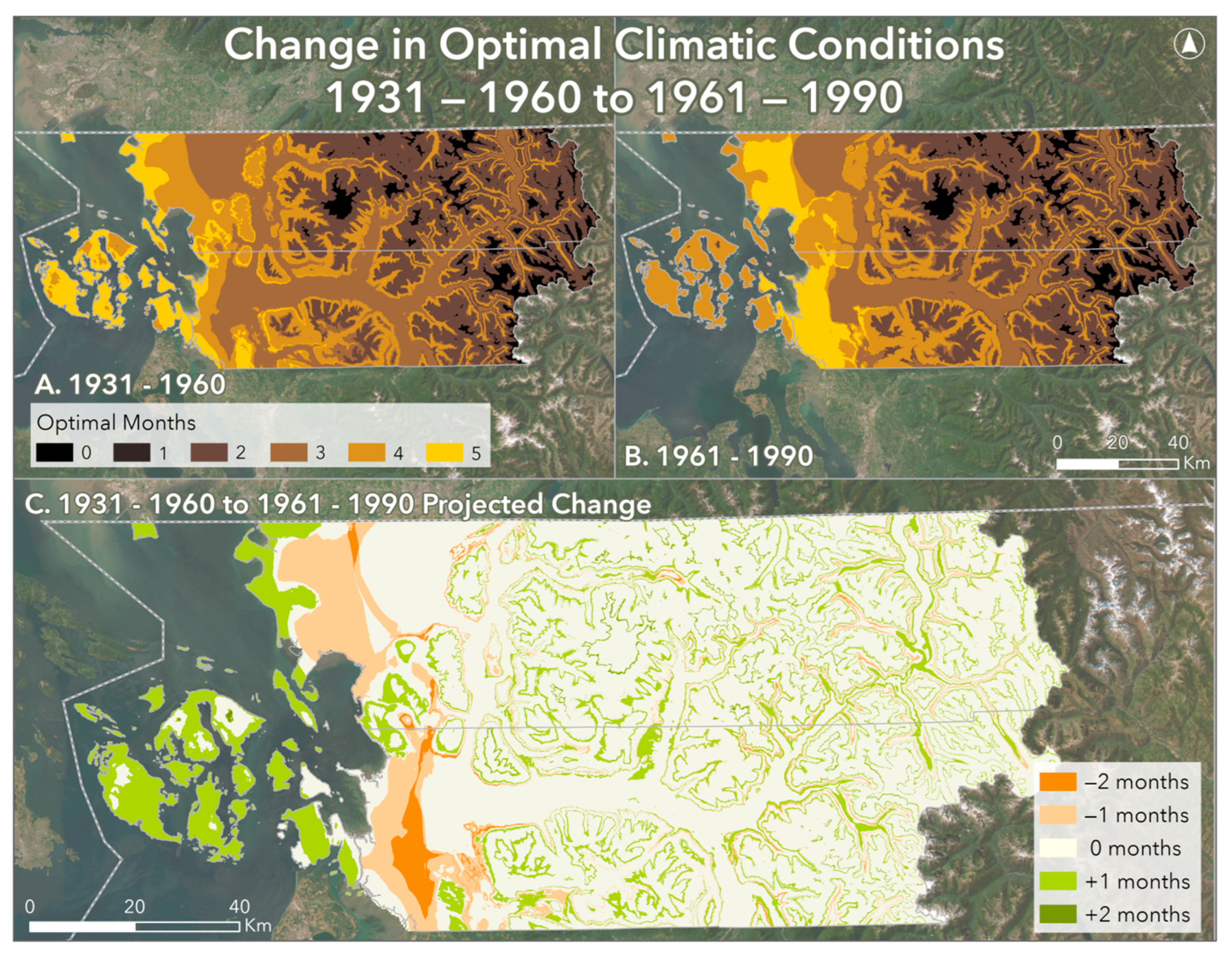
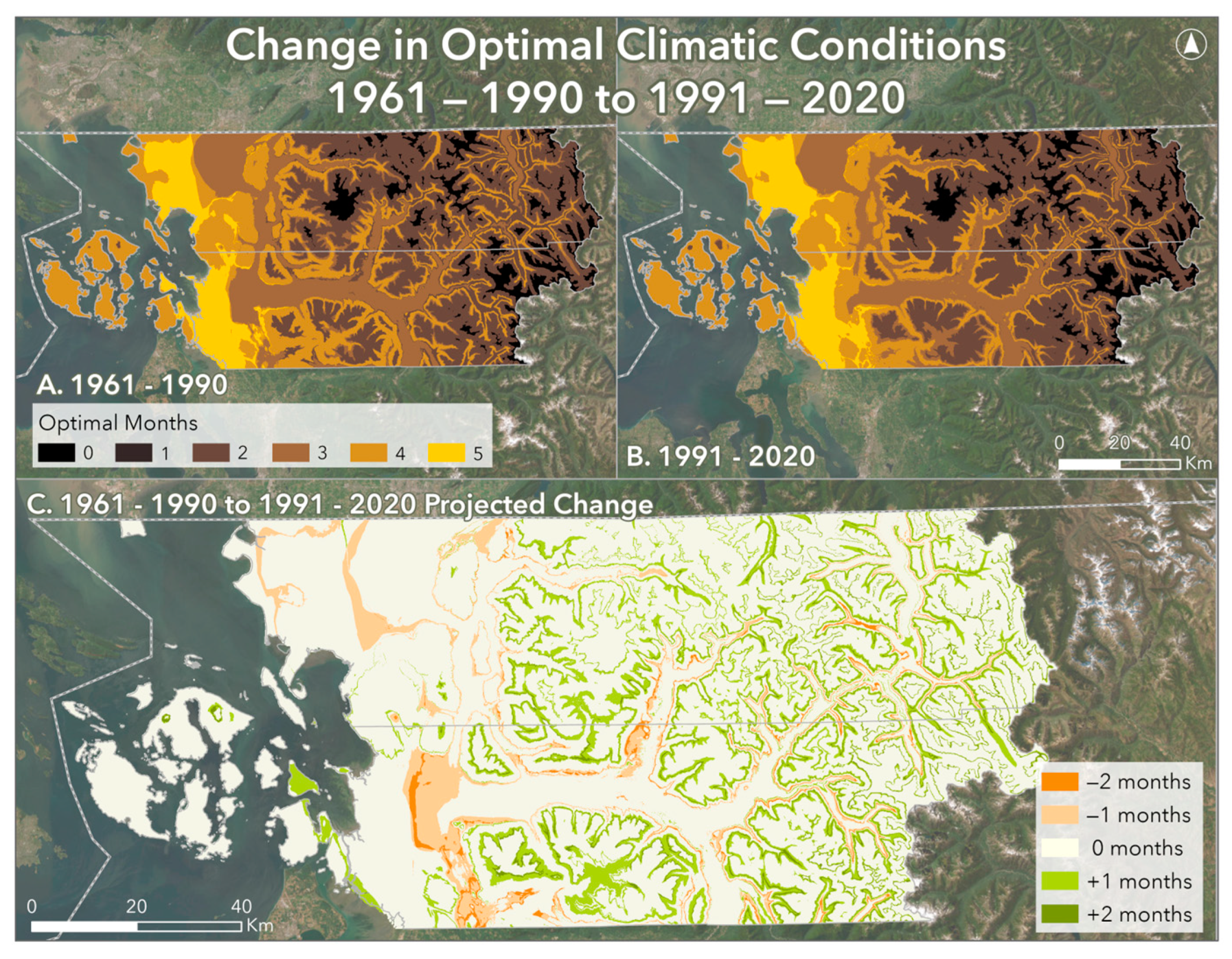
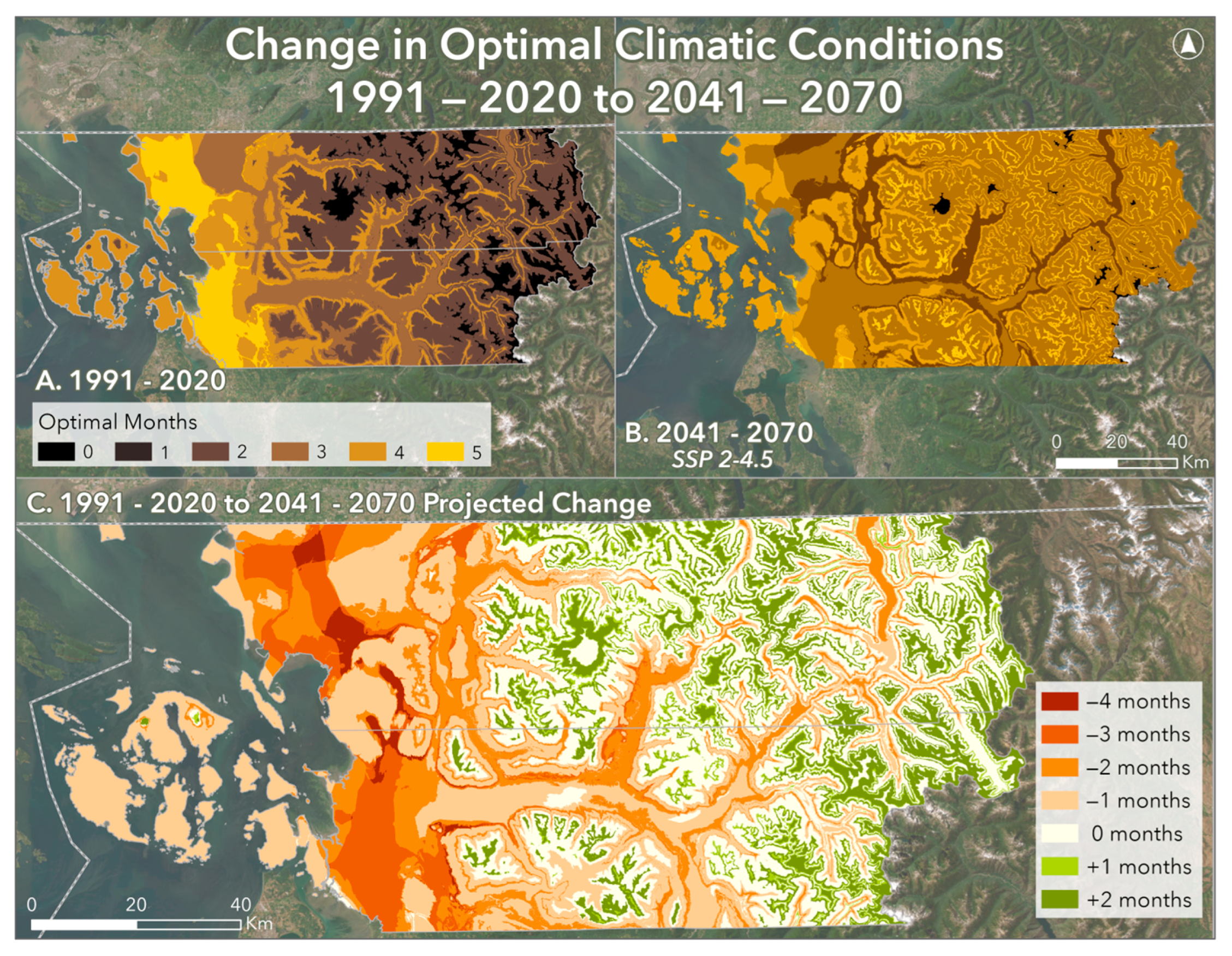
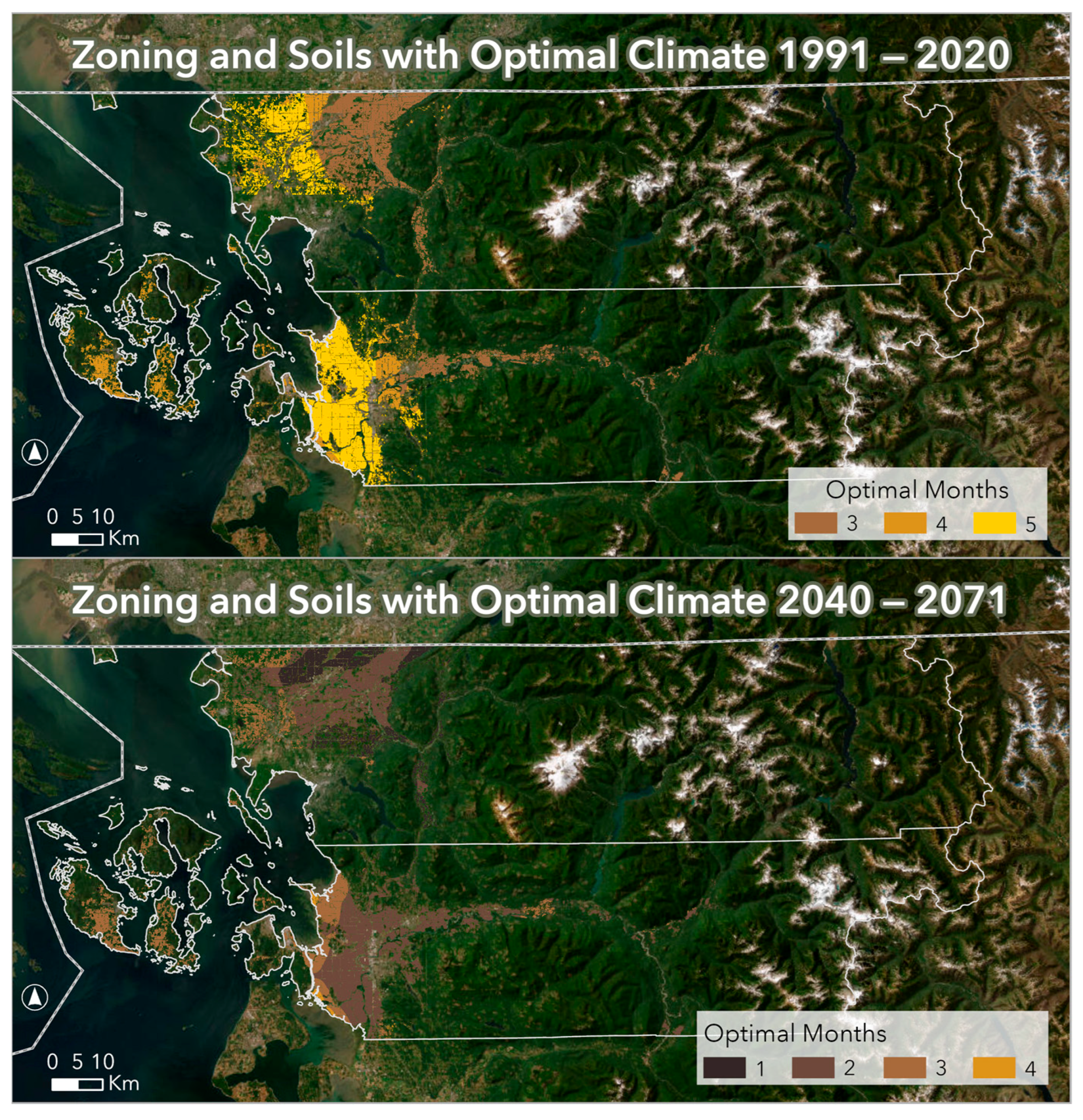
| Crops Included | Years |
|---|---|
| Barley, Buckwheat, Indian Corn, Oats, Rye, and Wheat | 1889 to 1945 |
| Barley, Oats, Rye, Triticale, and Wheat | 1950 to 2022 |
| Variables | Definition | Optimal Envelope | Suitable Envelope |
|---|---|---|---|
| TMIN01–TMIN12 | Minimum temperature per given month | >17 °C | >0 °C |
| TMAX01–TMAX12 | Maximum temperature per given month | <23 °C | <37 °C |
| Months of Climatic Suitability | Area of Agriculture Zoning (km2) | |
|---|---|---|
| 1991–2020 | 2041–2070 | |
| 1 | - | 133.3 |
| 2 | - | 449.28 |
| 3 | 258.1 | 200.95 |
| 4 | 159.43 | 6.87 |
| 5 | 374.14 | - |
Disclaimer/Publisher’s Note: The statements, opinions and data contained in all publications are solely those of the individual author(s) and contributor(s) and not of MDPI and/or the editor(s). MDPI and/or the editor(s) disclaim responsibility for any injury to people or property resulting from any ideas, methods, instructions or products referred to in the content. |
© 2025 by the authors. Licensee MDPI, Basel, Switzerland. This article is an open access article distributed under the terms and conditions of the Creative Commons Attribution (CC BY) license (https://creativecommons.org/licenses/by/4.0/).
Share and Cite
Furness, N.; Flower, A. The Effects of Climatic and Cultural Changes on Grain Agriculture in Northwest Washington. Geographies 2025, 5, 10. https://doi.org/10.3390/geographies5010010
Furness N, Flower A. The Effects of Climatic and Cultural Changes on Grain Agriculture in Northwest Washington. Geographies. 2025; 5(1):10. https://doi.org/10.3390/geographies5010010
Chicago/Turabian StyleFurness, Natalie, and Aquila Flower. 2025. "The Effects of Climatic and Cultural Changes on Grain Agriculture in Northwest Washington" Geographies 5, no. 1: 10. https://doi.org/10.3390/geographies5010010
APA StyleFurness, N., & Flower, A. (2025). The Effects of Climatic and Cultural Changes on Grain Agriculture in Northwest Washington. Geographies, 5(1), 10. https://doi.org/10.3390/geographies5010010





